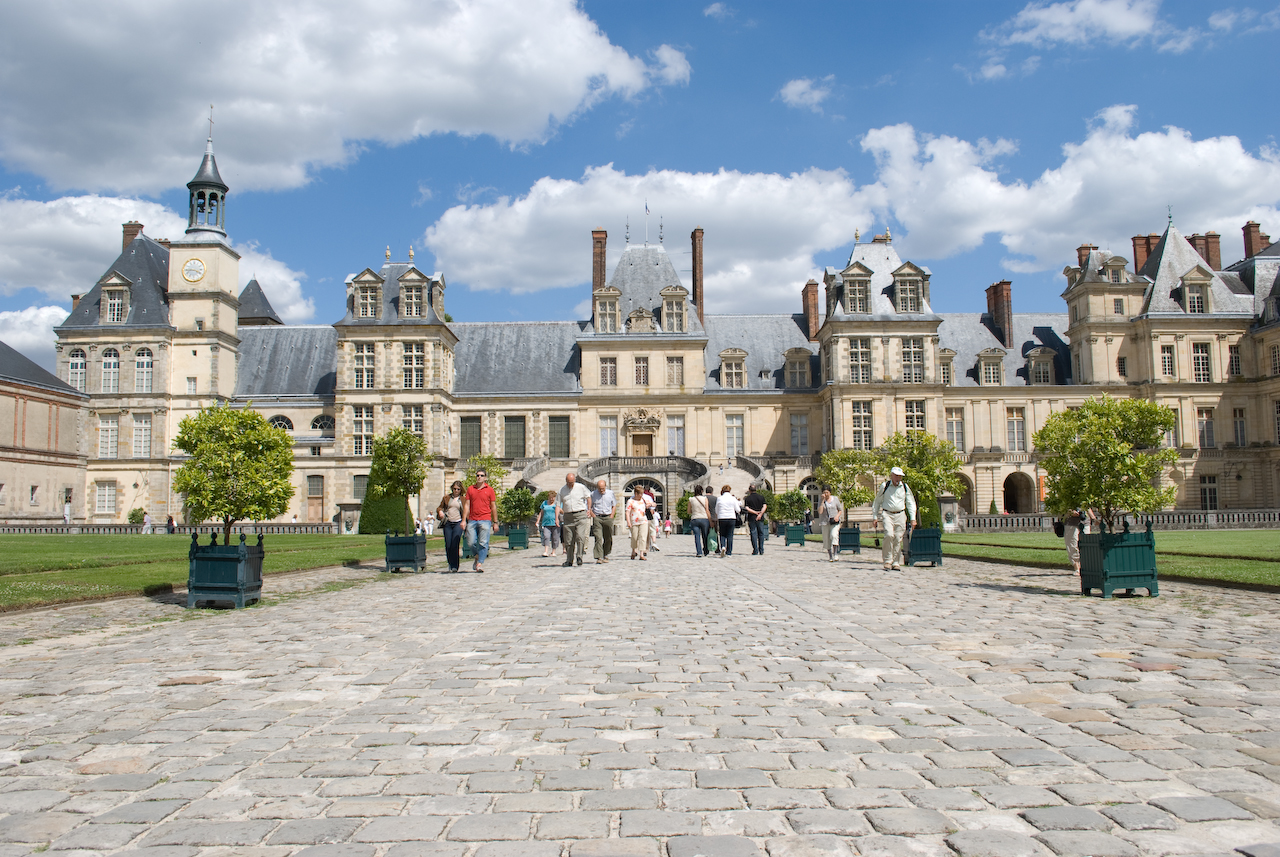Château de Fontainebleau in the commune of Fontainebleau, about 55 kilometers southeast of Paris, is one of the largest and most historically significant royal châteaux in France. A UNESCO World Heritage Site since 1981, this magnificent palace has served as a residence for French monarchs from the 12th century to the 19th century, witnessing many pivotal events in French history.
Château de Fontainebleau History

Early Beginnings
The origins of Château de Fontainebleau date back to the 12th century when it was initially constructed as a medieval hunting lodge. The site was chosen for its proximity to the vast and dense forest of Fontainebleau, which provided excellent hunting grounds for the French nobility.
Renaissance Transformation
The château underwent significant transformations during the reign of King Francis I (1515-1547), who is often credited with turning Fontainebleau into a true Renaissance palace. Inspired by his visits to Italy, Francis I invited Italian artists and architects, including Leonardo da Vinci, to enhance the château with Renaissance art and architecture. This period saw the addition of the iconic Horseshoe Staircase and the Galerie François I, adorned with exquisite frescoes and stuccoes.
Expansion and Enhancements
Successive monarchs continued to expand and embellish the château. Henry II, Catherine de’ Medici, and Henry IV all contributed to its development, adding new wings, courtyards, and gardens. The construction of the Grand Parterre, one of the largest formal gardens in Europe, was commissioned by Henry IV.
Baroque and Classical Influences
Under Louis XIII and Louis XIV, the château saw further enhancements with Baroque and Classical elements. The grand apartments, the Chapel of the Trinity, and the lavishly decorated ballroom, La Salle de Bal, were added during this period.
Napoleon and Beyond
Napoleon Bonaparte had a profound impact on Fontainebleau. He refurbished the palace, using it as a residence and a place to hold court. In 1814, Napoleon signed his first abdication here, marking a significant moment in the château’s history. After his return from exile, he briefly stayed at Fontainebleau during the Hundred Days.
Château de Fontainebleau Architecture and Interiors
Château de Fontainebleau boasts a fascinating architectural evolution. Originally a hunting lodge in the 12th century, it gradually transformed under the reign of various kings. Francis I, captivated by the Italian Renaissance, invited a host of Italian artists and architects, resulting in the palace’s stunning Renaissance courtyard and the opulent Galerie François I. Later monarchs added their own touches, creating a unique blend of architectural styles that reflects the changing tastes and times.
The Courtyards
The château features several grand courtyards, each with its unique character. The Cour du Cheval Blanc, or the White Horse Courtyard, is particularly notable for its elegant proportions and the famous Horseshoe Staircase.
The Apartments
The royal apartments are opulently decorated, reflecting the tastes and styles of different eras. The King’s and Queen’s apartments, the Pope’s apartment (created for Pope Pius VII during his imprisonment), and the sumptuous Napoleon I Museum, which includes the Emperor’s throne room, are among the highlights.
The Chapel of the Trinity
This chapel is a masterpiece of Baroque architecture, featuring intricate woodwork, paintings, and a stunning ceiling fresco. It served as the site for many royal baptisms and weddings.
The Galleries
The château’s galleries are renowned for their artistic significance. The Galerie François I is decorated with Renaissance frescoes by Rosso Fiorentino and Primaticcio, depicting mythological and allegorical themes.
Château de Fontainebleau Gardens and Park
The gardens of Fontainebleau are as impressive as the château itself. They include the Grand Parterre, designed by André Le Nôtre, the English Garden, with its naturalistic landscaping, and the Diana Garden, named after the Roman goddess of the hunt.
Cultural and Historical Significance
Château de Fontainebleau is not just an architectural gem but also a cultural treasure. It has been a witness to key historical events and has hosted numerous artists, writers, and intellectuals. Its rich history is reflected in the diverse architectural styles and the exquisite art collections housed within its walls.
Visiting Château de Fontainebleau
Today, Château de Fontainebleau is a major tourist attraction, drawing visitors from around the world. It offers a comprehensive look into French history and art, with guided tours available to explore its grand rooms, galleries, and gardens. Special exhibitions and events are held throughout the year, enhancing the visitor experience.
Château de Fontainebleau stands as a testament to the grandeur and evolution of French royal residences. Its combination of architectural splendor, artistic heritage, and historical importance makes it a must-visit destination for anyone interested in the cultural legacy of France.
Planning Your Visit to Château de Fontainebleau
Château de Fontainebleau is easily accessible from Paris by train or car. The palace is open daily, with extended hours during peak season. Be sure to purchase your tickets in advance, especially during peak times.
Embark on a journey to Château de Fontainebleau and discover a captivating blend of history, art, and architectural brilliance.
Have you ever visited the Château de Fontainebleau? Share your experience in the comments below!






0 Comment